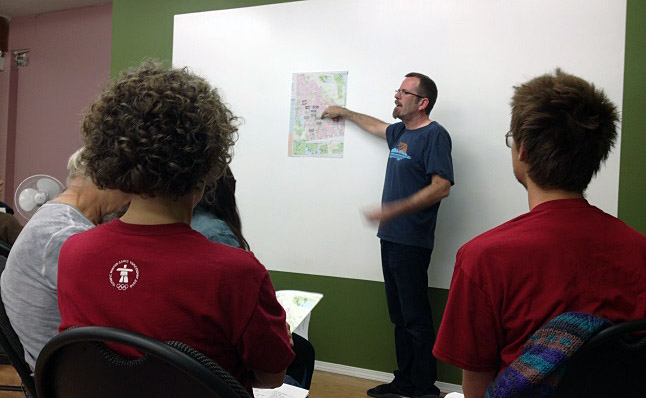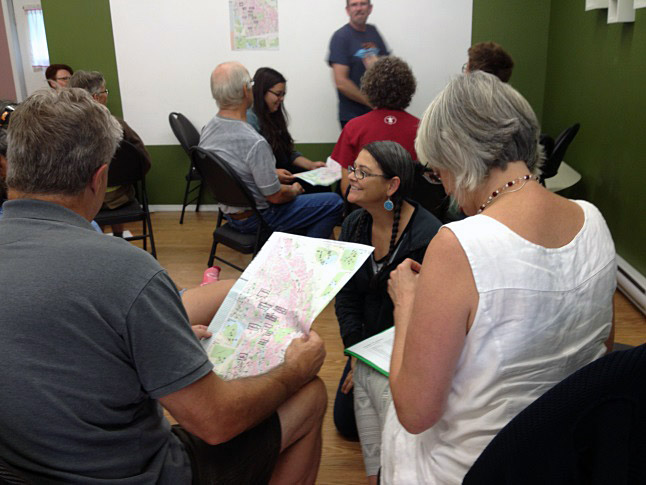By Laura Stovel
It was a language class like no other that I have ever attended – and I have been in many. For the participants, the class was deeply personal, deeply spiritual – and it was political. The class, held at the NaCoMo Wellness Centre in Nakusp, was teaching Nsyilxcen, the Interior Salish language shared by the Sinixt and Okanagan people.
Our teachers and course organizers were Sinixt, with the exception of Chris Parkin, the Irish-American principal of the Salish School of Spokane and a fluent Nsyilxcen speaker.

The Sinixt lived, hunted, gathered and fished in the Revelstoke area until the devastation of small pox epidemics in the early 1800s, and the arrival of miners and settlers along the Columbia River, beginning in the 1860s, profoundly destabilized them. With the lure of Fort Colvile, a Hudson’s Bay trading post (1825-1870) at Kettle Falls, the establishment of the international border in 1846, and the creation of the substantial Colville Reservation, shared by 11 tribes, in Washington in 1872, the Sinixt headed south for safety.
Although the vast majority of their territory was along the Columbia River in Canada and they had lived here for thousands of years, “Canada was a dangerous place” for the Sinixt, said Virgil Seymour, Arrow Lakes facilitator for the Sinixt, based on the Colville Reservation in Washington. The Canadian government only established a tiny reserve at Oatscott (near Burton) in 1902 which was not on land commonly used by the Sinixt. Few Sinixt moved to the reserve and in 1956 the Canadian government declared the Sinixt to be extinct, at least as a federally-recognized band.

“How long has it been since this many people gathered on this land saying these (Nsyilxcen) words?” Parkin asked the class. “About 100 years,” student Eileen Delehante-Pearkes said softly, almost in realization. Delehante-Pearkes should know. She is the author of a small but authoritative book on the Sinixt along the Columbia River, Geography of memory: Recovering stories of a landscape’s first people.
Learning language like a two-year-old
During the course, Language teacher LaRae Wiley took students through the themes of greetings, feelings, food and personal qualities using pictures. She discouraged us from writing and encouraged us to listen and try out the sounds “like a two-year-old would,” without expectations of mastery. It was a wonderful and effective way of learning because there was no translation from English. When a student saw a picture of a huckleberry, her mind went straight to the sound of the Nsyilxcen word.

The students in the class were specially invited by Seymour. Almost everyone present “has been helpful to me in one way or another” or has been recommended by someone. There were some Canadian and American Sinixt students, some students with aboriginal ancestry other than Sinixt and several non-aboriginal students. The course was designed for a maximum of 15 students but 22 students showed up and no one was turned away. This will be the first of several courses for this group.
Wiley is happy to teach anyone who wants to learn the language. “I have this philosophy that it took everybody to make the language go away between residential schools and all sorts of historical things that happened and I believe that it will take everyone to bring it back. We need everyone who just thinks that our language is beautiful to learn it.” She said she learned from her mentors that “If people want to learn and they have an open heart then you should teach them.”
The reaction of the students to the course was very positive. Patty Bailey, a Sinixt woman from Washington attended the course with her husband, Don. “My husband and I have been drawn to this area of our ancestors for many years and we thought it would be a good place for us to start down the road to learning the language,” she explained. “We want to do it with the community here.”
K.L. Kivi, a non-aboriginal student from the Nelson area said, “I think it’s super interesting and also challenging. The interesting thing is delving into a language that’s so different from any of the ones that I speak and is rooted in this land.”
The teachers’ and students’ enthusiasm was clear but the challenge ahead is daunting. Currently, there are only around 100 fluent speakers of Nsyilxcen (both Okanagan and Sinixt) in Canada and around 20 in the United States. Fluent speaker Shelly Boyd noted that there is only one fluent speaker who was born into the language on the reserve. Through determined efforts at the Salish School of Spokane and several Canadian organizations in the Okanagan, teachers are trying to bring the language back.
Quest for reattachment and recognition
For Seymour, organizing the course is part of an effort to gain recognition in Canada for his people. “It helps me to get our word out. We consider this to be the territory of our ancestors. The ultimate goal is to get the government to recognize that we are not extinct and that we should have rights to be consulted about our ancestors’ bones, our ancestors’ sacred places and resources.”
“I think we’ve always been good stewards of the land and, in my mind anyway, we have a right to take care of our ancestors’ homeland,” he said, adding that such stewardship benefits everyone.
Seymour has been to Revelstoke – known by the Sinixt as Skxikn (pronounced Skahikin) – several times, visiting schools, speaking at the June 21st storytelling festival, and visiting the Revelstoke Museum and Archives. “I love it up at Revelstoke,” he said. “It’s beautiful. I went up Mount Revelstoke and we did prayers and songs. That was real important to me, that the mountains hear our songs and hear our language again. I think that’s something that’s been absent from here for far too long.”



